Hamas and Palestinian Islamic Jihad (PIJ), the two militant movements in Gaza, have violently challenged Israel’s right to exist since their creation in the 1980s. Both have a similar agenda—to defeat Israel and create an Islamic state in historic Palestine. “The day that enemies usurp part of Muslim land, jihad becomes the individual duty of every Muslim,” Hamas said in its 1988 charter. Both groups rejected the 1993 Oslo peace accord between Israel and the PLO that created the Palestinian Authority. In a 1994 pamphlet, Fathi Shikaki, a physician and the co-founder of PIJ, decreed, “The only option to our people is continuation of the jihad with all our strength and to end the occupation.” Both Sunni militias have been trained, armed and financed by Iran. Both also have the same allies in Syria and Hezbollah, a Shiite militia and political party in Lebanon.
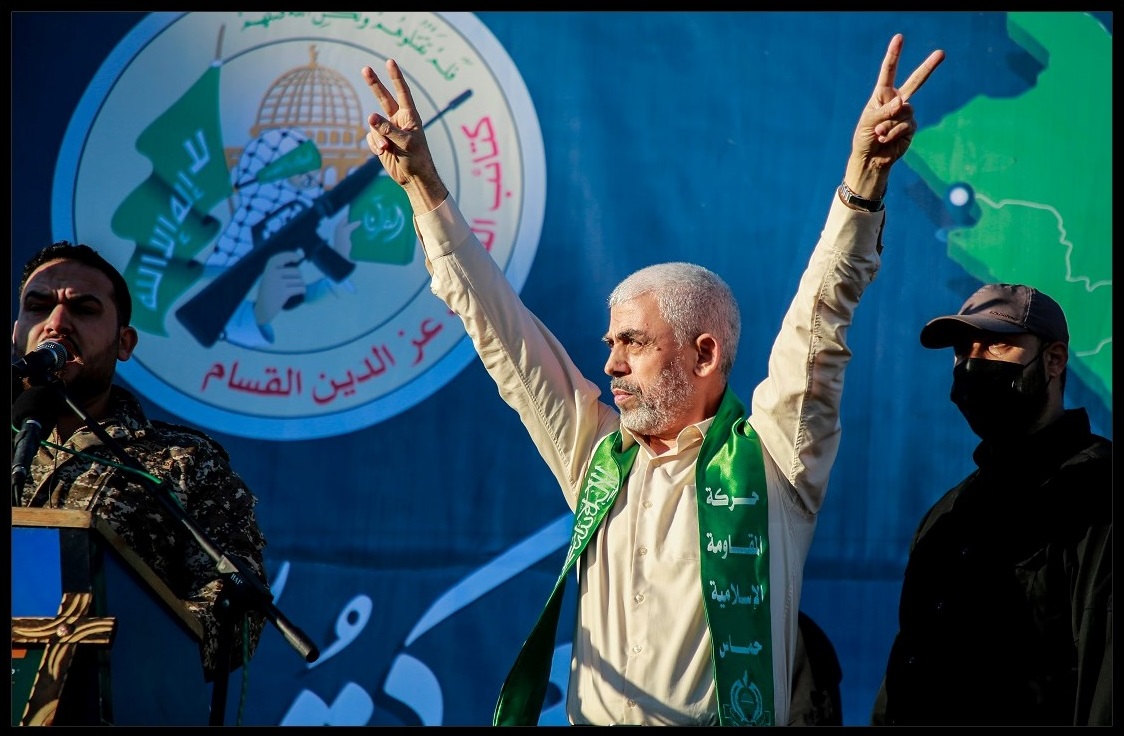
But Hamas and PIJ differ ideologically. PIJ, which was created as a small group of underground cells, has long been more extremist in ideology and tactics. Shikaki was born to a family of refugees in Gaza in 1951 and joined the Muslim Brotherhood while studying medicine in Egypt in the 1970s. He was heavily influenced by the ideology of Ayatollah Ruhollah Khomeini, the Iranian revolutionary leader. In 1979, Shikaki published a book, “Khomeini – The Islamic Solution and the Alternative,” that advocated for Sunni-Shiite unity in the struggle against Israel. Shikaki broke with the Muslim Brotherhood to prioritize the Palestinian cause. His books--including “The Shia and Sunna: An Unfortunate, Artificial Turmoil” published in 1985--promoted the same pan-Islamic vision espoused by Tehran. Shikaki was assassinated by Israel during a trip to Malta in 1995. His successor, Ramadan Shallah, also maintained close ties to Iran. “The Palestinian Islamic Jihad is another fruit of the Ayatollah Khomeini’s fructuous tree,” Shallah said during a 2002 meeting with Supreme Leader Ayatollah Ali Khamenei in Tehran.
Hamas, an Arabic acronym for the Islamic Resistance Movement, emerged in 1987 during the First Intifada, or uprising, against Israel’s military occupation of the West Bank and Gaza. Its origins were unrelated to Iran. Sheikh Ahmed Yassin, a quadriplegic and legally blind cleric, was the founder and spiritual leader. Born in 1936 in the village of al Jura, near the modern Israeli city of Ashkelon, he and his family fled to Gaza along with tens of thousands of other Palestinian refugees during the 1948 Arab-Israeli War. Like Shikaki, Yassin also spent time studying in Egypt and was inspired by the Muslim Brotherhood. But Hamas leaders promoted Palestinian nationalism in an Islamic framework – rather than Khomeini’s pan-Islamism. “Nationalism, from the point of view of the Islamic Resistance Movement, is part of the religious creed,” Hamas said in its 1988 charter. “Nothing in nationalism is more significant or deeper than in the case when an enemy should tread Muslim land.”
Relationship with Iran
Since the 1979 revolution, Iran has armed, trained and funded proxies across the Middle East. In some cases, it created allies, such as Hezbollah in Lebanon and a plethora of Shiite militias in Iraq. In other instances, Iran sponsored existing groups with overlapping goals, such as PIJ and Hamas in the Palestinian territories and the Houthis in Yemen. Iran’s support for PIJ and Hamas has enhanced its revolutionary credentials among Arabs and the wider Muslim world, only partly about the Palestinian issue. Iran’s goal has been to be the vanguard of the Islamic world, including in alliances with Sunni movements to transcend the sectarian divide.
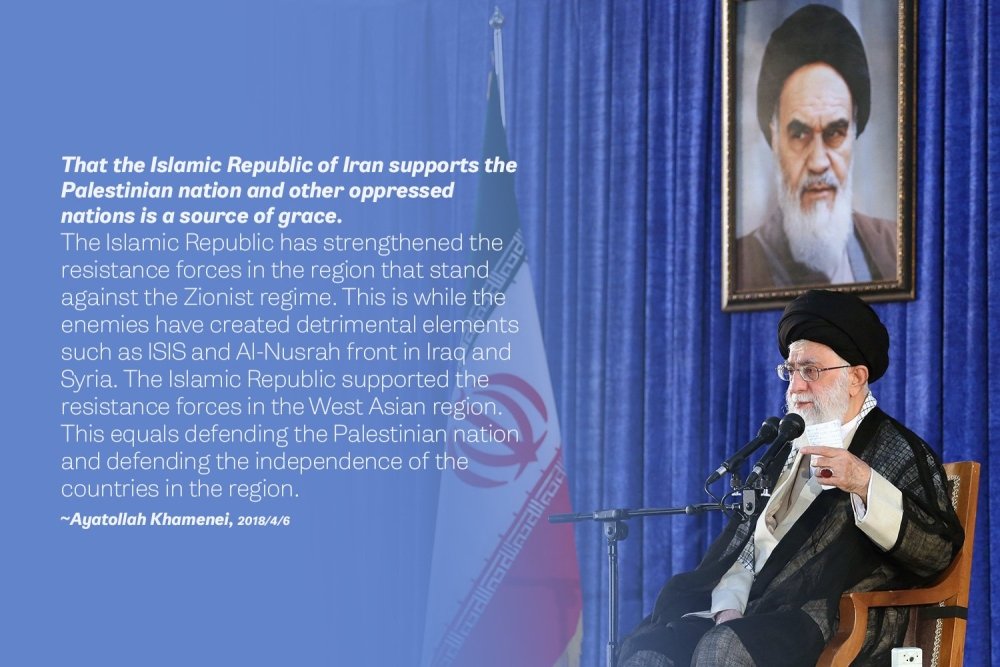
Hamas-Iran Ties
For more than three decades, Iran has provided financial support to Hamas, which ranged from $20 million to $50 million annually from 1990 to 2000. In 2008, Iran increased its financial support and increased the flow of weapons to Hamas. Iran reportedly produced or supplied many of the rockets fired by Hamas during the 2008-9 Gaza war with Israel. The conflicted ended when Israel declared a ceasefire in January 2009. The next month, Hamas political leader Khaled Mashaal visited Tehran. “You are our partners in the victory in Gaza,” he said in a speech. Mashaal also thanked Iran’s supreme leader and president “for all the financial, political and popular support which you have given to us. The Palestinian people will not forget.”
Iran’s relationship with Hamas frayed when the Syrian civil war erupted in 2011. Hamas backed the Syrian rebels, while Iran backed the government of President Bashar Assad. As ties deteriorated, Iran suspended funding to Hamas in 2012. Relations began to improve after Hamas selected Yahya Sinwar to the political bureau chief of Hamas in Gaza. Iran and Hamas reconciled in 2017, and Tehran resumed its funding. “Relations with Iran are excellent and Iran is the largest supporter of the Izz ad Din al Qassam Brigades with money and arms,” Sinwar said in August 2017. “The relationship today is developing and returning to what it was in the old days.”
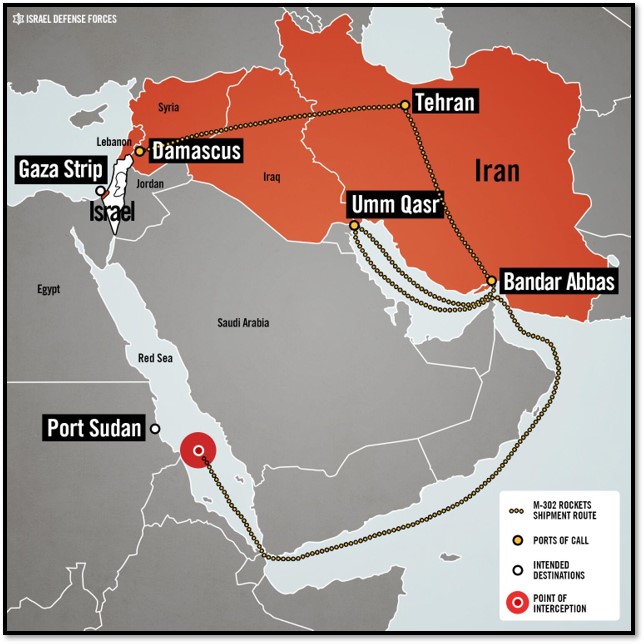
Historically, Iran smuggled weapons to Hamas via Sudan, where the IRGC Qods Force operated warehouses and trained on rocket production, Fabian Hinz, an expert on missile proliferation, told The Iran Primer. Rockets were then smuggled via Egypt to the Sinai Peninsula through tunnels into Gaza. Smuggling became increasingly difficult after Egypt started sealing off or destroying Hamas tunnels in 2013 and Sudan cut diplomatic relations with Iran in 2016.
Iran increasingly trained Hamas fighters in Gaza and helped develop local weapons production. “Instead of giving them a fish or teaching them to catch a fish, we taught our allies and friends how to make a hook, and they are now in possession of missile capabilities and technologies,” General Amir Ali Hajizadeh, the commander of the IRGC Aerospace Force, said in January 2021. “Today, the Palestinians fire rockets instead of throwing stones.”
Hamas leaders have repeatedly expressed appreciation for Iranian support. “I give thanks to those who provided funds and weaponry to the courageous resistance, the Islamic Republic of Iran, [which] has not skimped in extending funds, weaponry, and technology to the resistance,” Haniyeh said on a Hamas Telegram channel in May 2021. The State Department estimated that Iran provided Hamas with about $100 million pear year as of 2023.
In October 2023, Iranian leaders applauded Hamas for its multi-pronged attack on Israel. Supreme Leader Khamenei called the unprecedented operation “a devastating earthquake” and a “great calamity” for Israel, even though the Palestinian group committed murderous atrocities and hostage seizures of Israeli civilians from homes, streets and even a music festival in central and southern Israel. In a telephone call with Haniyeh, President Ebrahim Raisi called the attack “the fulfillment of the 70-year-old expectation of the Palestinian nation and the Islamic Ummah (nation).”
PIJ-Iran Ties
Khomeini influenced the ideology of PIJ co-founders Shikaki and Abd al Aziz Awda, a preacher. Iran started funding PIJ in 1987, according to Shikaki. PIJ ties with Tehran deepened after Israel deported Shikaki and other PIJ operatives to Lebanon in 1988. Iran’s Revolutionary Guards provided funding and military support to PIJ at camps in Lebanon and Syria. In 1991, Iran hosted PIJ, Hamas, and other groups for a conference, the International Committee for the Support of the Palestinian Intifada. Tehran sought to counter the Madrid Peace Conference convened that same year to solve the Israeli-Palestinian conflict.
PIJ increasingly depended on Iran for support. Starting in 2000, Iran reportedly paid PIJ millions of dollars in cash bonuses for each attack against Israel during the Second Intifada, which lasted until 2005. In 2002, Khamenei promised to increase support by 70 percent. “It is no secret that we say that the military assistance provided to the Palestinian resistance – from A to Z, from bullet to rocket – is assistance from the Islamic republic, Iranian assistance,” PIJ spokesman Dawud Shihab said in 2012.
PIJ-Iran relations appeared strained in 2015. Iran reportedly stopped or curtailed its financial support after PIJ refused to denounce the Saudi-led offensive against the Houthis, the Iran-backed rebels in Yemen. Tehran shifted support to the smaller and short-lived al Sabirin movement (or “the Patient”), which was headed by Hisham Salem, a former PIJ operative. But the Islamic Republic resumed support for PIJ in 2016. Aid increased to $30 million in 2018, according to Israeli media. “I am proud to say that the rockets that are used to pound Tel Aviv have an Iranian signature on them,” Ramez al Halabi said during clashes with Israel in May 2021.
In October 2023, Iranian leaders praised PIJ for participating in the Hamas-led attack on Israel. “What happened in the occupied territories and in the battle with the usurping Zionist regime was a huge, unique event in the past 70 years, and you really made the Islamic community happy with this innovative and victorious operation,” President Raisi told Nakhalah during a phone call. “We consider the final victory of the Palestinian nation to be a divine promise and the Iranian nation always stands by the freedom-loving and independent nations, and at the top of them is the Palestinian nation.”
Evolution of Hamas and PIJ
Hamas and PIJ have offered alternatives to the secular and nationalist movements, notably Yasser Arafat’s Fatah Party and two socialist parties--the Democratic Front for the Liberation of Palestine and the Popular Front for the Liberation of Palestine. But Hamas has offered social services, including schools, health care clinics, and charities since the 1990s. It waded into politics by running in the 2006 parliamentary elections. In a major political upset, it won a majority of seats—76 out of 132. It has ruled Gaza since ejecting the Palestinian Authority government in 2007. Hamas has since then balanced resistance against Israel with the day-to-day governance of 2.2 million Palestinians. In contrast, PIJ has remained a relatively small militia.
For decades, both groups were dogmatically opposed to a two-state solution and were committed to Israel’s destruction—at whatever personal cost. “Jihad is its path and death for the sake of Allah is the loftiest of its wishes,” Hamas said in its 1988 charter. The goals of PIJ, as described in a manifesto from the 2000s, include rejection of “any peaceful solution to the Palestinian cause.” It believes that jihad and martyrdom are “the only choice for liberation.”
But the two movements have diverged on Israel. In 2017, Hamas released a new manifesto that provisionally supported the creation of a Palestinian state based on borders before the 1967 war. (Israel captured the West Bank, Gaza, the Sinai Peninsula, the Golan Heights and East Jerusalem in the six-day war in a devastating blow to Palestinians.) “Hamas rejects any alternative to the full and complete liberation of Palestine, from the river to the sea,” Hamas said in its 2017 manifesto. “However, without compromising its rejection of the Zionist entity and without relinquishing any Palestinian rights, Hamas considers the establishment of a fully sovereign and independent Palestinian state, with Jerusalem as its capital along the lines of the 4th of June 1967, with the return of the refugees and the displaced to their homes from which they were expelled, to be a formula of national consensus.” Hamas still reserved its right to “resistance and jihad” but appeared to be much more pragmatic in dealing with Israel. In contrast PIJ has never accepted the idea of a long-term hudna, or truce, with Israel.
Relations between PIJ and Hamas have historically been contentious. Hamas has disagreed with some of the PIJ attacks on Israel, which have elicited Israeli counterstrikes that risked a more protracted conflict with Israel. They have occasionally been rivals competing for Palestinian support or for resources from Iran. At other times, they have collaborated in the fight against Israel.
Hamas: Military Wing
Hamas launched its first military operations against Israel in 1989. In separate attacks, it kidnapped and killed two Israeli soldiers in southern Israel. It stepped up attacks after establishing a military wing of underground cells--the Izz ad din al Qassam Brigades--in 1991. The militia was named after a Syrian-born preacher and militant who opposed Zionism as well as the British and French presence in the Middle East during from the 1920s. In the 1930s, he recruited hundreds of fighters, mainly among the rural poor, for the Black Hand, which attacked Jewish settlements and sabotaged British rail lines. He was killed in a shoot-out with British police near Jenin. He quickly became a hero among Palestinians and symbol of their cause.
Hamas has attacked both Israeli military and civilian targets. It became infamous for suicide bombings and shootings at bus stops, restaurants and discos in the 1990s and 2000s. Hamas had a freer hand to operate in Gaza after the Israeli military withdrew in 2005. With the help of Iran and Hezbollah, it evolved into a larger, more disciplined, and better-equipped fighting force capable of pummeling Israeli towns with thousands of rockets and launching hit-and-run incursions over the Gaza border.
By 2023, the Hamas militia had built a diverse inventory of weapons, including rockets, drones, mortars, incendiary balloons, and even torpedoes. The CIA has estimated its force at up to 25,000, while Israel and Western media reported up to 40,000 fighters. It concealed weapons, some provided from Iran and others crafted locally, in a vast network of tunnels underneath Gaza.
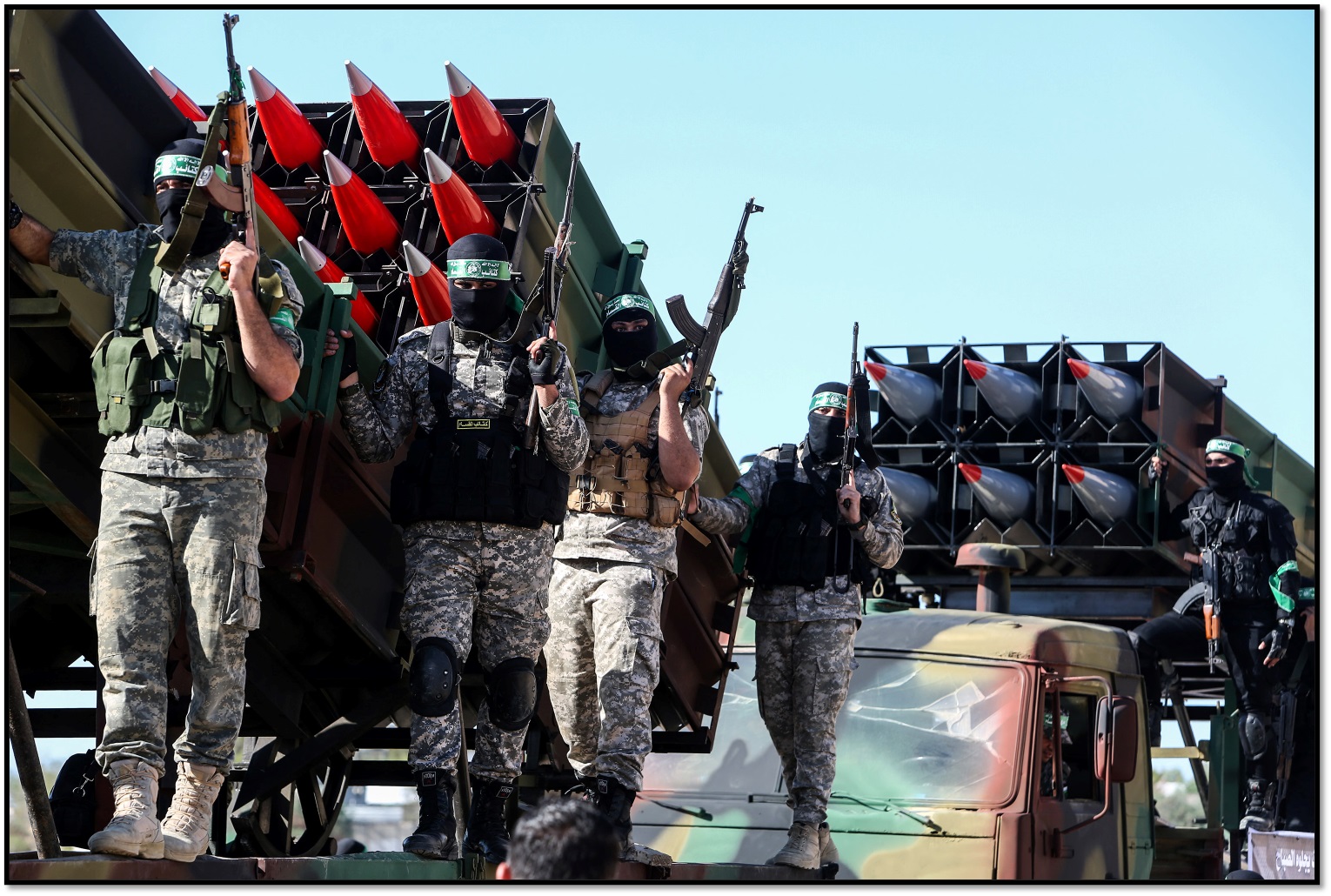
Hamas fighters—some 1,200 trained militants, plus hundreds more from Palestinian Islamic Jihad and Gaza civilians who joined in after Hamas breached the security barrier around Gaza—demonstrated unprecedented capabilities in attacks on civilian kibbutzim communities and southern military bases on Oct. 7, 2023. Hamas used drones and snipers to cripple Israel’s communications and early warning systems along the border. It coordinated air, land, and sea operations on 22 Israeli communities. It launched at least 2,200 rockets at southern and central Israel. Some reached Tel Aviv and Jerusalem, which Hamas rockets had rarely been able to reach in previous hostilities.
Militants also perpetrated atrocities. They killed more than 1,400 civilians and soldiers in bloodthirsty massacres, which included murder, rape and beheadings of children, females and the elderly. Some Israelis were burned alive while they hid in safe rooms. More than 300 were soldiers, officers and reservists in the Israeli military were killed. The vast majority were civilians. Hamas had not employed such grisly tactics in the past. Hamas and PIJ also took more than 200 hostages back to Gaza.
Hamas: Political Wing
Hamas ran for the first time in the 2006 legislative elections. Many Palestinians looked to Hamas as an alternative to the ruling Fatah party, which had gained a reputation for corruption and ineffectiveness after four decades of dominating Palestinian politics. Although Hamas won 74 out of 132 seats, the party did not expect to have to form a government for the entire Palestinian Authority and make policy decisions. Fatah refused to join a Hamas-led government, so President Mahmoud Abbas – a longtime Fatah member and ally of Yasser Arafat—ruled from the capital in Ramallah in the West Bank while Hamas effectively governed Gaza. Abbas placed security forces in Gaza under his control. In response, Hamas created its own parallel security force. Tensions boiled over in 2007 when Hamas believed that Fatah forces were planning to remove the Hamas government from office in Gaza. Hamas seized control of Gaza, while the Palestinian Authority retained control over the West Bank.
Since the Hamas takeover, Israel and Egypt have maintained a blockade on Gaza that has caused an economic crisis for Palestinians. Repeated negotiations between Hamas and Fatah—brokered by Egypt, Qatar and Syria—to form a Palestinian unity government failed. The Palestinian Authority has been unable to hold elections since 2006. In 2021, Abbas postponed scheduled elections. He cited Israel’s refusal to guarantee that Palestinians in East Jerusalem could vote, although Hamas and other secular Palestinians wanted to hold the poll anyway. “In Hamas, we don’t want to turn the situation into an internal Palestinian struggle. We want the language of dialogue, communication and dialogue to prevail among all Palestinians,” Haniyeh said.
Leadership
Yahya Sinwar: Sinwar’s family fled or were expelled from al Majdal Asqalan, in what is now southern Israel, during the 1948 Arab-Israeli War. He was born in 1962 in a refugee camp in Khan Yunis, Gaza. Sinwar became politically active in the early 1980s while studying at the Islamic University of Gaza, where he earned a bachelor’s degree in Arabic studies. Sinwar was arrested by Israel in 1982 and reportedly held for four months in administrative detention with no formal charges. He was arrested again in 1985 and held for eight months.
Sinwar joined Hamas when it was established in 1987 and co-founded its internal security service in 1988. Israel sentenced him to four life terms in prison for orchestrating the abduction and murder of two Israeli soldiers and four suspected Palestinian “collaborators” in 1988. Israeli officials dubbed him “the butcher of Khan Yunis” because of his brutality of other Palestinians. Sinwar served 22 years. In 2011, Israel released him and 1,026 other Palestinians in exchange for Gilad Shalit, a soldier abducted by Hamas in 2006. The United States put Sinwar on “Specially Designated Global Terrorist” list in 2015. The Hamas Shura Council elected him to head the political bureau in Gaza in 2017. Sinwar was willing to compromise with the Palestinian Authority and engage in a hudna – or ceasefire—with Israel, according to Palestinian experts. “The offensive that Sinwar was mainly focused on was sending a shock to the Israeli political system [to] provide him with the necessary leverage to have a much wider exchange of prisoners and a more comprehensive deal” with Israel, Khalil Shikaki, a Palestinian academic and pollster, said at the Carnegie Endowment on Nov. 2, 2023.
Ismail Haniyeh: Haniyeh’s family fled from al Majdal Asqalan, in what is now southern Israel, during the 1948 Arab-Israeli War. Born in 1962 in the Shati refugee camp in Gaza, he joined the Islamic Student Bloc while a student in 1984. He graduated with a degree in Arabic literature from the Islamic University in Gaza in 1987. When the First Intifada broke out, he participated in anti-Israel protests and joined Hamas. He spent six months in an Israeli prison in 1988 and another three years starting in 1989. Israel deported him and hundreds of other Palestinian militants to Lebanon in 1992.
After the PLO signed the Oslo Accord with Israel in 1993, he returned to Gaza to head the Islamic University. He quickly climbed the ranks within Hamas. In 2001, he became the third-highest ranking official. In 2006, he headed the Hamas list in its first run for parliament. After Hamas upset the secular Fatah Party, Haniyeh was appointed prime minister of the Palestinian Authority. Hamas forced Fatah—its political officials and security forces -- out of Gaza in 2007. Palestinian President Abbas dismissed him, but Haniyeh remained the de facto leader of Gaza until Hamas leaders elected him to head the 15-person Politburo in 2017. The United States labeled him a “Specially Designated Global Terrorist” in 2018. He left Gaza in 2019 and set up an office in Qatar. Haniyeh was reelected head of the Politburo in 2021.
Khaled Mashaal: Mashaal was born in 1956 in Silwad, a West Bank town. He and his family fled to Kuwait during the 1967 Arab-Israeli War. Mashaal was devout from a young age and joined the Muslim Brotherhood at 15. He received a degree in physics from Kuwait University and founded a student group called the List of the Islamic Right. Mashaal has been involved in Hamas since its inception, despite living in Kuwait. He founded a Kuwaiti chapter of Hamas but left the country when Iraq invaded in 1990. He moved to Amman, Jordan, where he headed the local Hamas chapter. He was elected the head of Hamas Politburo in 1996.
Mashaal survived a botched assassination attempt by Israel in 1997. Two Mossad agents sprayed poison into his ear but were caught trying to escape. The ordeal earned him the title of “living martyr.” Jordan expelled Mashaal and senior Hamas leaders in 1999 for “illicit and harmful” activities that could undermine national security. After a stint in Qatar, he set up an office in Damascus, Syria in 2001. The United States labeled Mashaal along with five other Hamas leaders as “Specially Designated Global Terrorists” in 2003.
After Israel assassinated Hamas founder Sheikh Yassin in 2004, Mashaal became the overall leader of Hamas. He relocated from Damascus to Doha in 2012, after Hamas and Iran backed different actors in the Syrian civil war. In 2017, Haniyeh was elected to replace Mashaal. But the latter made a comeback in 2021 when he was elected head of the diaspora division, the second-highest ranking position.
PIJ: Military Wing
PIJ has had the second-largest fighting force in Gaza after Hamas. Its mission is to fight Israelis and replace the Jewish state, according to leaders. “The call to jihad and resisting the occupation should precede all other activities,” Shallah said in 1998. It recruited primarily among young and educated men in Gaza willing to engage in bombings, suicide missions and assassinations against Israeli forces and settlers. But unlike Hamas, it has not provided social services, schools or health services so has not built wider public support. It also rejects political engagement, so has built no formal constituency. The difference between the two movements is that Hamas, which governs Gaza, has had to consider the costs—and potential backlash—of any operation against Israel. PIJ does not.
PIJ launched its first attack on Israeli targets in Gaza in 1984. Shikaki and other PIJ leaders gained military training and new allies after Israel deported them to Lebanon in the late 1980s. Shikaki traveled to Tehran, where he met with Ayatollah Khomeini and was promised new aid and arms. Iran’s Revolutionary Guards training the PIJ deportees at Hezbollah camps in Lebanon. PIJ and Hezbollah fighters began joint attacks on Israeli targets. In 1989, PIJ moved its headquarters to Damascus but maintained fighters in southern Lebanon.
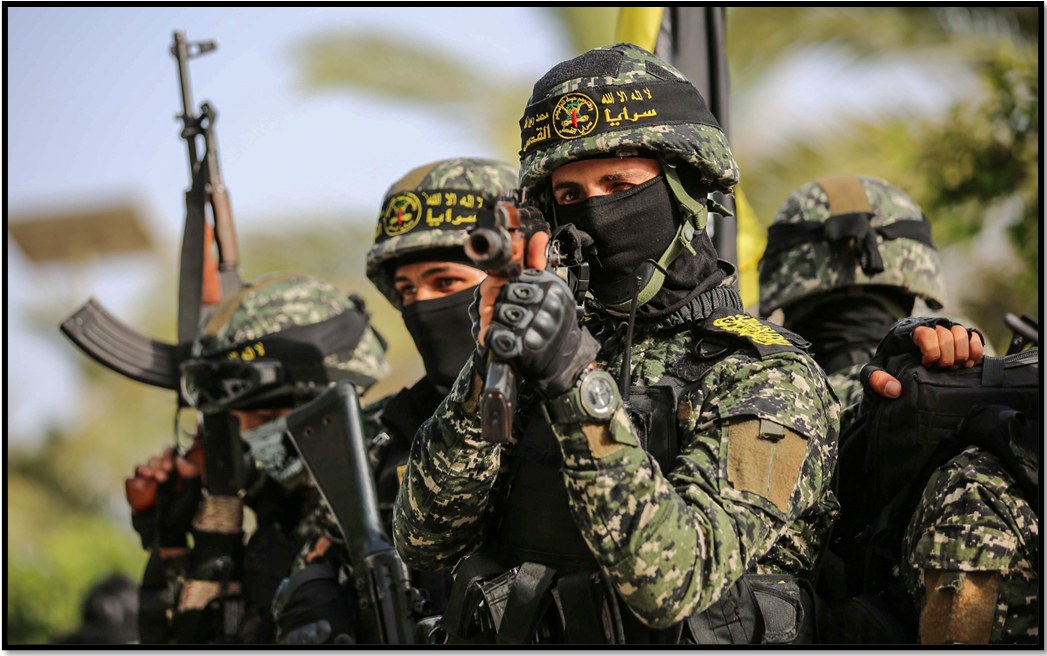
In 1992, PIJ established the al Quds Brigades as a formal military wing. It rejected the Oslo Accords between Israel and the PLO in 1993. Throughout the 1990s, it escalated attacks on Israel in an attempt to derail the peace process. Its attack on a bus stop killed 21 Israeli soldiers and one civilian in 1995. During the Second Intifada from 2000 to 2005, PIJ carried out suicide missions, car bombings and mass killings on both military and civilian targets deep inside Israeli, including a pizzeria and bus stop in Jerusalem.
Since 2018, PIJ has coordinated some of its operations against Israel with Hamas and 10 other militant groups at joint operations room in Gaza. The others included armed wings of secular groups such as Fatah, the PFLP and the DFLP. But PIJ has often acted independently, however. In 2019, 2022 and May 2023, PIJ conducted limited clashes with Israel, and Hamas stayed out of the fighting. But Hamas led the unprecedented Oct. 7, 2023 assault on Israel. After Hamas militants broke through the Israeli security barrier around Gaza, PIJ fighters reportedly followed a few hours later. They claimed to have taken 30 hostages back to Gaza.
By 2023, its fighting force ranged from 1,000 to several thousand, according to State Department estimates. PIJ could have up 15,000 fighters, according to Western media and Israeli experts. Its weapons included more than a dozen types of rockets, some produced locally and others from Iran smuggled through tunnels from Egypt.
PIJ cells have historically been concentrated in Gaza but they have also operated in the West Bank. In 2021, PIJ commanders Jamil al Amouri and Wiam Iyad Hanon established the Jenin Battalion, a cross-factional militant group based in Jenin, a hub for militant activity. Israel killed Jamil al Amouri in June 2021 and Hanon in October 2023.
Leadership
Ziyad al Nakhalah: Nakhalah was born in 1953 in Khan Yunis, Gaza. His father was killed during the 1956 Suez Crisis. Nakhalah earned a bachelor’s degree from the Gaza Teachers Institute. Israel arrested Nakhalah for the first time in 1971 for his involvement in the Arab Liberation Forces, a militant group. He was sentenced to life in prison but was released 14 years later as part of a prisoner swap with Israel in 1985. Three Israeli soldiers were freed in exchange for 1,150 Palestinians and Lebanese prisoners.
After his release, Nakhalah organized the PIJ military wing. In 1988, Israel arrested him for involvement in the First Intifada and deported him and other militants to Lebanon. Nakhalah became the PIJ representative in Beirut. After Israel assassinated Shikaki in 1995, PIJ officials selected Ramadan Shallah to lead PIJ, with Nakhalah as deputy secretary general. The United States labeled Nakhalah a “Specially Designated Global Terrorist” in 2014. In 2018, Shallah reportedly had a stroke and was hospitalized in Beirut. Nakhalah replaced him.
